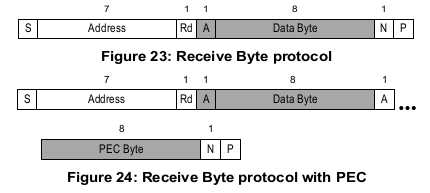标签:cts 增加 bytes The packet class src required use
SMBus一种I2C总线的变种
SMBus 提供了PEC方式,提高了传输的可靠性。
总线的发展都是在提高速度,提高可靠性或者提高传输效率上下功夫。
PEC不具备纠错的能力,是在I2C link layer增加了一种手段来有效的检验传输的数据是否有错。
PEC : Packet Error Code (CRC-8 error checking)
6.4 Packet Error Checking
The Packet Error Checking mechanism improves reliability and communication robustness. Implementation of Packet Error Checking by SMBus devices is optional for SMBus devices but is required for devices participating in and only during the ARP process. SMBus devices that implement Packet Error Checking must be capable to communicate with the host and other devices that do not implement the Packet Error Checking mechanism.(兼容)
Packet Error Checking, whenever applicable, is implemented by appending a Packet Error Code (PEC) at the end of each message transfer. Each protocol (except for Quick Command and the host notify protocol described Section 6.5.9) has two variants: one with the Packet Error Code (PEC) byte and one without. The PEC is a CRC-8 error-checking byte, calculated on all the message bytes (including addresses and read/write bits). The PEC is appended to the message by the device that supplied the last data byte.
6.4.1 Packet error checking implementation
The SMBus must accommodate any mixture of devices that support Packet Error Checking and devices that do not. A device that acts as a slave and supports the PEC must always be prepared to perform the slave transfer with or without a PEC, verify the correctness of the PEC if present, and only process the message if the PEC is correct. Implementations are encouraged to issue a NACK if the PEC is present but not correct.
6.4.1.1 ACK/NACK and Packet Error Checking
The ACK/NACK bit in a SMBus byte is as susceptible to corruption as any other bit in a SMBus packet. Hence, an ACK at the end of a PEC is not a guarantee that the PEC is correct. A master-transmitter receiving an ACK at the end of a write should not necessarily assume that the write was successfully carried out at the slave-receiver of the write, although it is highly likely that it was.
A NACK received after a PEC by a master-transmitter indicates that the link layer of the slave-receiver became aware of an error with the transmission in time to supply a NACK at the end of the PEC byte. This may be due to an incorrect PEC or any other error. Errors discovered above the data link layer may also be indicated with a NACK if the device is fast enough to discover and indicate the error when the NACK is due.
An ACK received after a PEC by a master-transmitter means that no error could be determined by the link layer in the slave-receiver in time to supply a NACK. This might be because the receiver is not able to check the validity of the PEC in real time.
If a master transmitter wants to be sure that a write-operation is performed correctly at the target device, it must use some higher-layer mechanism to verify this. This might take the form of a read-with-PEC of the data; receipt of a correct PEC would reliably indicate that that the original write occurred without error.
When a master-receiver reads data from a slave-transmitter, the ACK/NACK supplied by the master-receiver at the end of the transaction has little meaning other than to mark the end of the last byte. The slave-transmitter is supplying the data, and if the PEC supplied by the slave-transmitter is correct, the master-receiver may assume that the data was received as the slave transmitted it. If not, it is up to the master-receiver to take any appropriate remedial action.
6.4.1.2 Master implementation
A master may use PEC on any transaction. It is required that the master have either a priori knowledge of whether or not the target slave supports PEC or a way to determine whether the target slave supports PEC. The use of PEC is governed by upper layer protocols (e.g. device drivers), specifications (e.g. requirements of the SMBus ARP protocol) or detection algorithms for a given class of devices (e.g. smart batteries).
6.4.1.3 Slave implementation
A slave device that implements Packet Error Checking must be prepared to receive and transmit data with or without a PEC. During a slave receive transfer, after the device has identified the protocol and command, it must accept and check the additional PEC for validity.
During a slave transmit transfer, the slave transmitter must respond to additional clocks after the last byte transfer and furnish a PEC to the master receiver
requesting it.
Each bus transaction requires a Packet Error Code (PEC) calculation by both the transmitter and receiver within each packet. The PEC uses an 8-bit cyclic
redundancy check (CRC-8) of each read or write bus transaction to calculate a Packet Error Code (PEC). The PEC may be calculated in any way that conforms to a CRC-8 represented by the polynomial, C(x) = x 8 + x 2 + x 1 + 1, and must be calculated in the order of the bits as received.
Calculating the PEC for transmission or reception is implemented in a method chosen by the device manufacturer. It is possible to perform the check with a low-cost hardware or a firmware algorithm that could process the message bit-by-bit or with a byte-wise look-up table. The SMBus web page provides some example CRC-8 methods.
The PEC is appended to the message as dictated by the protocols in Section 6.5. The PEC calculation includes all bytes in the transmission, including
address, command and data. The PEC calculation does not include ACK or NACK bits or START, STOP or REPEATED START conditions. This means that the PEC is computed over the entire message from the first START condition.




标签:cts 增加 bytes The packet class src required use
原文地址:https://www.cnblogs.com/eesky/p/11286930.html